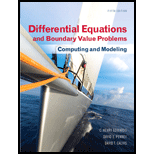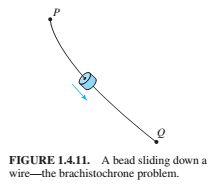
Concept explainers
Figure 1.4.11 shows a bead sliding down a frictionless wire from point P to point Q. The brachistochrone problem asks what shape the wire should be in order to minimize the bead’s time of descent from P to Q. In June of 1696. John Bernoulli proposed this problem as a public challenge, with a 6-month deadline (later extended to Easter 1697 at George Leibniz’s request). Isaac Newton, then retired from academic life and serving as Warden of the Mint in London, received Bernoulli’s challenge on January 29, 1697. The very next day he communicated his own solution—the curve of minimal descent time is an arc of an inverted cycloid—to the Royal Society of London. For a modern derivation of this result, suppose the bead starts from rest at the origin P and let
where

(a) First derive from Eq. (1) the differential equation
where a is an appropriate positive constant.
(b) Substitute
for which
Want to see the full answer?
Check out a sample textbook solution
Chapter 1 Solutions
MyLab Math with Pearson eText -- 24-Month Standalone Access Card -- For Differential Equations and Boundary Value Problems: Computing and Modeling Tech Update
Additional Engineering Textbook Solutions
Problem Solving with C++ (10th Edition)
Starting Out with Java: From Control Structures through Objects (7th Edition) (What's New in Computer Science)
Starting Out With Visual Basic (8th Edition)
Starting Out with Python (4th Edition)
Java How to Program, Early Objects (11th Edition) (Deitel: How to Program)
- In cell C21, enter a formula to calculate the number of miles you expect to drive each month. Divide the value of number of miles (cell A5 from the Data sheet) by the average MPG for the vehicle multiplied by the price of a gallon of gas (cell A6 from the Data sheet).arrow_forwardMicrosoft Excelarrow_forwardIn cell C16, enter a formula to calculate the price of the vehicle minus your available cash (from cell A3 in the Data worksheet). Use absolute references where appropriate—you will be copying this formula across the row what fomula would i use and how do i solve itarrow_forward
- What types of data visualizations or tools based on data visualizations have you used professionally, whether in a current or past position? What types of data did they involve? What, in your experience, is the value these data views or tools added to your performance or productivity?arrow_forwardQuestion: Finding the smallest element and its row index and column index in 2D Array: 1. Write a public Java class min2D. 2. In min2D, write a main method. 3. In the main method, create a 2-D array myArray with 2 rows and 5 columns: {{10, 21, 20, 13, 1}, {2, 6, 7, 8, 14}}. 4. Then, use a nested for loop to find the smallest element and its row index and column index. 5. Print the smallest element and its row index and column index on Java Consolearrow_forward(using R)The iris data set in R gives the measurements in centimeters of the variables sepal length and width andpetal length and width, respectively, for 50 flowers from each of 3 species of iris, setosa, versicolor, andvirginica. Use the iris data set and the t.test function, test if the mean of pepal length of iris flowers isgreater than the mean of sepal length.The iris data set in R gives the measurements in centimeters of the variables sepal length and width andpetal length and width, respectively, for 50 flowers from each of 3 species of iris, setosa, versicolor, andvirginica. Use the iris data set and the t.test function, test if the mean of pepal length of iris flowers isgreater than the mean of sepal length.arrow_forward
- Recognizing the Use of Steganography in Forensic Evidence (4e)Digital Forensics, Investigation, and Response, Fourth Edition - Lab 02arrow_forwardWrite a Java Program to manage student information of a university. The Javaprogram does the following steps:a) The program must use single-dimensional arrays to store the studentinformation such as Student ID, Name and Major.b) The program asks the user to provide the number of students.c) The program asks the user to enter the Student IDs for the number of studentsand stores them.d) The program asks the user to enter the corresponding names for the numberof students and stores them.e) The program then asks the user to provide the corresponding major for thestudents and stores them.f) The program then should display the following options:1. ID Search2. Major Enrollment3. Exitg) On selecting option 1, the user can search for a student using Student ID. Theprogram asks the user to enter a Student ID. It then should print thecorresponding student’s details such as Name and Major if the user providedStudent ID number is present in the stored data. If the user’s Student IDnumber does not…arrow_forward(a) Algebraically determine the output state |q3q2q1q0> (which is a 4-qubitvector in 16-dimensional Hilbert space). Show all steps of your calculations. (b) Run a Qiskit code which implements the circuit and append threemeasurement gates to measure the (partial) output state |q2q1q0> (which is a 3-qubit vector in 8-dimensional Hilbert space). this is for quantum soft dev class, you can use stuff like Deutsch Jozsa if u wantarrow_forward
- Write a C++ program that will count from 1 to 10 by 1. The default output should be 1, 2, 3, 4, 5, 6 , 7, 8, 9, 10 There should be only a newline after the last number. Each number except the last should be followed by a comma and a space. To make your program more functional, you should parse command line arguments and change behavior based on their values. Argument Parameter Action -f, --first yes, an integer Change place you start counting -l, --last yes, an integer Change place you end counting -s, --skip optional, an integer, 1 if not specified Change the amount you add to the counter each iteration -h, --help none Print a help message including these instructions. -j, --joke none Tell a number based joke. So, if your program is called counter counter -f 10 --last 4 --skip 2 should produce 10, 8, 6, 4 Please use the last supplied argument. If your code is called counter, counter -f 4 -f 5 -f 6 should count from 6. You should count from first to last inclusively.…arrow_forwardWrite a program that will count from 1 to 10 by 1. The default output should be 1, 2, 3, 4, 5, 6 , 7, 8, 9, 10 There should be only a newline after the last number. Each number except the last should be followed by a comma and a space. To make your program more functional, you should parse command line arguments and change behavior based on their values. Argument Parameter Action -f, --first yes, an integer Change place you start counting -l, --last yes, an integer Change place you end counting -s, --skip optional, an integer, 1 if not specified Change the amount you add to the counter each iteration -h, --help none Print a help message including these instructions. -j, --joke none Tell a number based joke. So, if your program is called counter counter -f 10 --last 4 --skip 2 should produce 10, 8, 6, 4 Please use the last supplied argument. If your code is called counter, counter -f 4 -f 5 -f 6 should count from 6. You should count from first to last inclusively. You…arrow_forwardWas What is the deference betwem full At Adber and Hold?arrow_forward
 C++ for Engineers and ScientistsComputer ScienceISBN:9781133187844Author:Bronson, Gary J.Publisher:Course Technology Ptr
C++ for Engineers and ScientistsComputer ScienceISBN:9781133187844Author:Bronson, Gary J.Publisher:Course Technology Ptr Principles of Information Systems (MindTap Course...Computer ScienceISBN:9781285867168Author:Ralph Stair, George ReynoldsPublisher:Cengage Learning
Principles of Information Systems (MindTap Course...Computer ScienceISBN:9781285867168Author:Ralph Stair, George ReynoldsPublisher:Cengage Learning Operations Research : Applications and AlgorithmsComputer ScienceISBN:9780534380588Author:Wayne L. WinstonPublisher:Brooks Cole
Operations Research : Applications and AlgorithmsComputer ScienceISBN:9780534380588Author:Wayne L. WinstonPublisher:Brooks Cole New Perspectives on HTML5, CSS3, and JavaScriptComputer ScienceISBN:9781305503922Author:Patrick M. CareyPublisher:Cengage Learning
New Perspectives on HTML5, CSS3, and JavaScriptComputer ScienceISBN:9781305503922Author:Patrick M. CareyPublisher:Cengage Learning EBK JAVA PROGRAMMINGComputer ScienceISBN:9781305480537Author:FARRELLPublisher:CENGAGE LEARNING - CONSIGNMENT
EBK JAVA PROGRAMMINGComputer ScienceISBN:9781305480537Author:FARRELLPublisher:CENGAGE LEARNING - CONSIGNMENT





